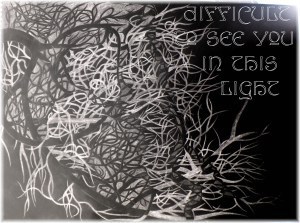A trigger moment
I will never forget the day I was standing at my laundry trough and my former husband entered the room. I knew it was him. I sensed him behind me and made to turn and say Hi. I think of that recognition as logical, rational deduction. But something else happened. My body gave a jolt and I yelped. It was the delay between the two reactions that struck me as odd. And it’s why I believe cognitive behaviour therapy (CBT) in the treatment of trauma-related amygdala damage can only ever hope to manage the symptoms and offers no cure.
The amygdala are our emotional (including fight-flight) response mechanism, closely tied to the hypothalamus which regulates the sympathetic and parasympathetic nervous systems, and the hippocampus or memory storage unit. Here’s a good summation of the interactions of these three brain areas and how they are affected by trauma. http://www.washacadsci.org/Journal/Journalarticles/V.93-3-Post%20Traumatic%20Stress%20Disorder.%20Sethanne%20Howard%20and%20Mark%20Crandalll.pdf
”Cognitive behavioral psychotherapy is a treatment approach that addresses the thought processes which trigger a person’s emotional responses. Instead of perceiving a situation as threatening, individuals learn to use logical thinking processes to change how they perceive a situation.” http://www.ehow.com/about_5372442_amygdala-anxiety-cure.html For a fuller account go here – http://www.aacbt.org/viewStory/WHAT+IS+CBT%3F
In the example above, my thought processes had not triggered the emotional response. It was as if my brain was split, with one part functioning in its ordinary way, and another in a traumatised way. My husband was equally surprised. ”Why did you jump like that when you knew it was me?” I had no answer. I had not perceived the situation of his presence as threatening. I had no reason to feel frightened or on edge.
Which is why I assert that CBT, while of great value, cannot change perception in advance. It can only change the thought processes that may reinforce a particular sort of emotional response, create a more positive and calm mental environment, and alter perceptions through positive rationalisations or self-talk after the trigger event.
Whether CBT, along with self-regulation, mindfulness, meditation, relaxation and EMDR, can retrain the amygdala is as far as I can tell, unknown. I have not found scientific evidence that demonstrates a cure of damaged amygdala. While there are claims that such a thing can be achieved, my investigations have led me to conclude that false claims by sham operators promoting their ”proven” techniques abound.
I am also aware that in the field of practitioner psychotherapists, the urge to fix is paramount. And the profession does a great job in the area of effective symptom relief. Yet clients come in, do some sessions, leave after some positive results, and that tends to be it. Where’s the follow up? How are these types in two, five years time?
I am not a neuroscientist or a psychologist. All I know is that I live intimately with my own brain. After decades of therapy and bucket loads of self-help I am aware of its shenanigans. I make every effort not to enter negative and fear-reinforcing thought patterns. I undo every knot I can find. It’s a lonely and vulnerable place to be.
Placing my creative self at the centre of my being has been my most successful move to date. Yet doing so is also a risk for she is shadow material, ill-formed, almost deranged by raw emotion, exceptionally driven and, having lived in a cage in a dungeon for decades, she’s shifted her cage upstairs. After wondering for years why I’ve been retreating from the world around me in order to write my books, I suddenly understood that I’m dumped in the cage with her. Looking out through the bars, I smile, for I am aware. She has become my master, and I her dutiful slave and together we tell tales. Sometimes the urge to reveal my truth overcomes me, as occurred when I wrote The edge will do just fine for ABC Open.
I’m writing this blog piece in response to well-meaning types who have been telling me lately that I can be fixed. I don’t get a chance to tell them I’m still managing a dicky amygdala and the consequent responses in my sympathetic nervous system before they leap in with advice. The implication in their words is that I am still not fixed because I am stuck, stubbornly holding on to negative thoughts, to memories, to past hurts, and that I must learn to forgive and let go.
All that I am is negated through their words. All that occurs in me in these moments is a quiet shrinking away.
I hope I have made clear here that my difficulties do not begin and end with healing the wounds.
My creativity is called Scarlet and we are besties. I’m not lonely any more and I am less and less vulnerable and more and more defiant. Scarlet is a veil stripper and I must let her have her voice. So be it.
Filed under: Uncategorized Tagged: amygdala, CBT, child abuse, cognitive behaviour therapy, complex ptsd, domestic violence, emotional response, post traumatic stress disorder, ptsd, therapy, thought processes, trauma, trigger response





